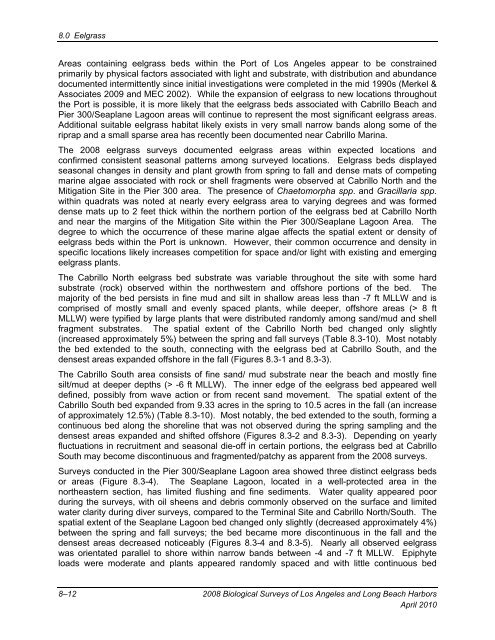appendix b final 2008 biological surveys of los angeles and long ...
appendix b final 2008 biological surveys of los angeles and long ...
appendix b final 2008 biological surveys of los angeles and long ...
Create successful ePaper yourself
Turn your PDF publications into a flip-book with our unique Google optimized e-Paper software.
8.0 Eelgrass<br />
Areas containing eelgrass beds within the Port <strong>of</strong> Los Angeles appear to be constrained<br />
primarily by physical factors associated with light <strong>and</strong> substrate, with distribution <strong>and</strong> abundance<br />
documented intermittently since initial investigations were completed in the mid 1990s (Merkel &<br />
Associates 2009 <strong>and</strong> MEC 2002). While the expansion <strong>of</strong> eelgrass to new locations throughout<br />
the Port is possible, it is more likely that the eelgrass beds associated with Cabrillo Beach <strong>and</strong><br />
Pier 300/Seaplane Lagoon areas will continue to represent the most significant eelgrass areas.<br />
Additional suitable eelgrass habitat likely exists in very small narrow b<strong>and</strong>s a<strong>long</strong> some <strong>of</strong> the<br />
riprap <strong>and</strong> a small sparse area has recently been documented near Cabrillo Marina.<br />
The <strong>2008</strong> eelgrass <strong>surveys</strong> documented eelgrass areas within expected locations <strong>and</strong><br />
confirmed consistent seasonal patterns among surveyed locations. Eelgrass beds displayed<br />
seasonal changes in density <strong>and</strong> plant growth from spring to fall <strong>and</strong> dense mats <strong>of</strong> competing<br />
marine algae associated with rock or shell fragments were observed at Cabrillo North <strong>and</strong> the<br />
Mitigation Site in the Pier 300 area. The presence <strong>of</strong> Chaetomorpha spp. <strong>and</strong> Gracillaria spp.<br />
within quadrats was noted at nearly every eelgrass area to varying degrees <strong>and</strong> was formed<br />
dense mats up to 2 feet thick within the northern portion <strong>of</strong> the eelgrass bed at Cabrillo North<br />
<strong>and</strong> near the margins <strong>of</strong> the Mitigation Site within the Pier 300/Seaplane Lagoon Area. The<br />
degree to which the occurrence <strong>of</strong> these marine algae affects the spatial extent or density <strong>of</strong><br />
eelgrass beds within the Port is unknown. However, their common occurrence <strong>and</strong> density in<br />
specific locations likely increases competition for space <strong>and</strong>/or light with existing <strong>and</strong> emerging<br />
eelgrass plants.<br />
The Cabrillo North eelgrass bed substrate was variable throughout the site with some hard<br />
substrate (rock) observed within the northwestern <strong>and</strong> <strong>of</strong>fshore portions <strong>of</strong> the bed. The<br />
majority <strong>of</strong> the bed persists in fine mud <strong>and</strong> silt in shallow areas less than -7 ft MLLW <strong>and</strong> is<br />
comprised <strong>of</strong> mostly small <strong>and</strong> evenly spaced plants, while deeper, <strong>of</strong>fshore areas (> 8 ft<br />
MLLW) were typified by large plants that were distributed r<strong>and</strong>omly among s<strong>and</strong>/mud <strong>and</strong> shell<br />
fragment substrates. The spatial extent <strong>of</strong> the Cabrillo North bed changed only slightly<br />
(increased approximately 5%) between the spring <strong>and</strong> fall <strong>surveys</strong> (Table 8.3-10). Most notably<br />
the bed extended to the south, connecting with the eelgrass bed at Cabrillo South, <strong>and</strong> the<br />
densest areas exp<strong>and</strong>ed <strong>of</strong>fshore in the fall (Figures 8.3-1 <strong>and</strong> 8.3-3).<br />
The Cabrillo South area consists <strong>of</strong> fine s<strong>and</strong>/ mud substrate near the beach <strong>and</strong> mostly fine<br />
silt/mud at deeper depths (> -6 ft MLLW). The inner edge <strong>of</strong> the eelgrass bed appeared well<br />
defined, possibly from wave action or from recent s<strong>and</strong> movement. The spatial extent <strong>of</strong> the<br />
Cabrillo South bed exp<strong>and</strong>ed from 9.33 acres in the spring to 10.5 acres in the fall (an increase<br />
<strong>of</strong> approximately 12.5%) (Table 8.3-10). Most notably, the bed extended to the south, forming a<br />
continuous bed a<strong>long</strong> the shoreline that was not observed during the spring sampling <strong>and</strong> the<br />
densest areas exp<strong>and</strong>ed <strong>and</strong> shifted <strong>of</strong>fshore (Figures 8.3-2 <strong>and</strong> 8.3-3). Depending on yearly<br />
fluctuations in recruitment <strong>and</strong> seasonal die-<strong>of</strong>f in certain portions, the eelgrass bed at Cabrillo<br />
South may become discontinuous <strong>and</strong> fragmented/patchy as apparent from the <strong>2008</strong> <strong>surveys</strong>.<br />
Surveys conducted in the Pier 300/Seaplane Lagoon area showed three distinct eelgrass beds<br />
or areas (Figure 8.3-4). The Seaplane Lagoon, located in a well-protected area in the<br />
northeastern section, has limited flushing <strong>and</strong> fine sediments. Water quality appeared poor<br />
during the <strong>surveys</strong>, with oil sheens <strong>and</strong> debris commonly observed on the surface <strong>and</strong> limited<br />
water clarity during diver <strong>surveys</strong>, compared to the Terminal Site <strong>and</strong> Cabrillo North/South. The<br />
spatial extent <strong>of</strong> the Seaplane Lagoon bed changed only slightly (decreased approximately 4%)<br />
between the spring <strong>and</strong> fall <strong>surveys</strong>; the bed became more discontinuous in the fall <strong>and</strong> the<br />
densest areas decreased noticeably (Figures 8.3-4 <strong>and</strong> 8.3-5). Nearly all observed eelgrass<br />
was orientated parallel to shore within narrow b<strong>and</strong>s between -4 <strong>and</strong> -7 ft MLLW. Epiphyte<br />
loads were moderate <strong>and</strong> plants appeared r<strong>and</strong>omly spaced <strong>and</strong> with little continuous bed<br />
8–12 <strong>2008</strong> Biological Surveys <strong>of</strong> Los Angeles <strong>and</strong> Long Beach Harbors<br />
April 2010
















